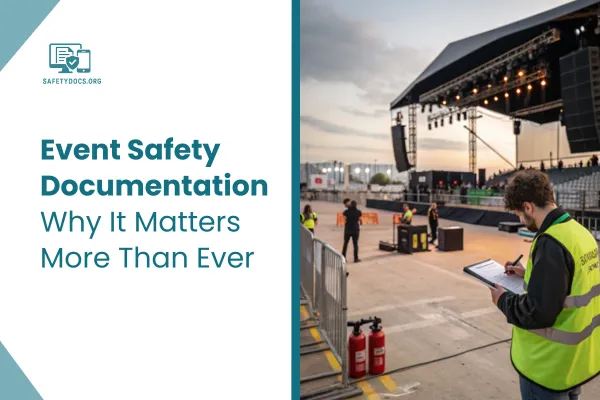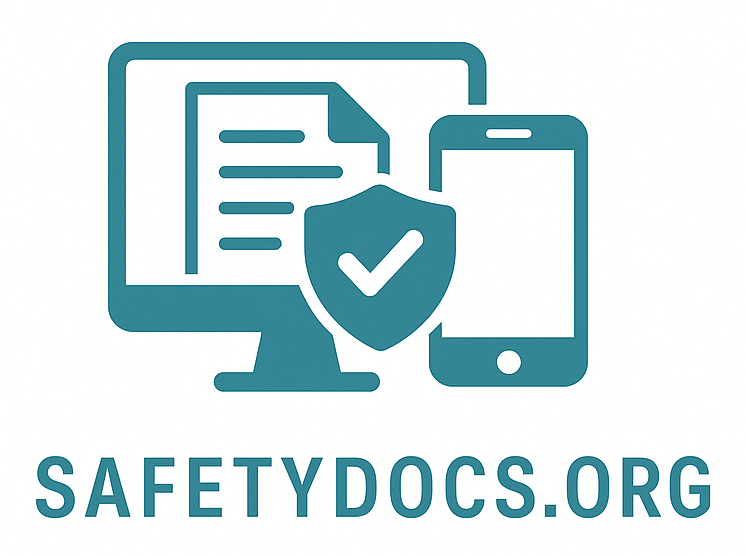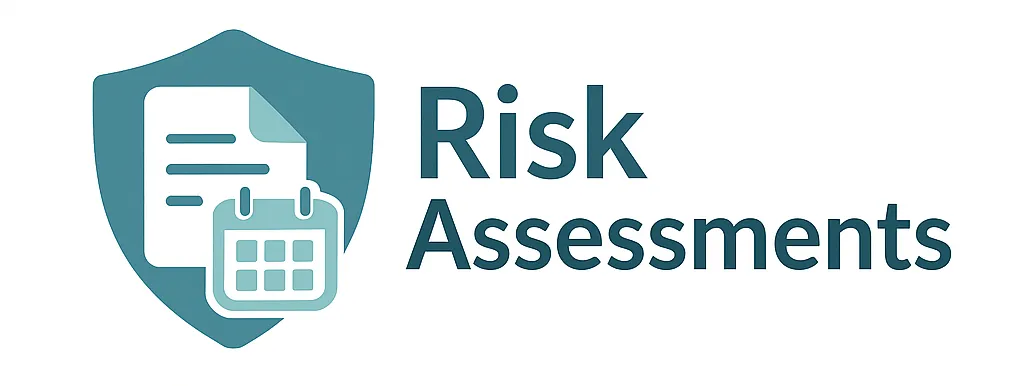
Event Safety Documentation Best Practices
Event Safety Documentation: Why It Matters More Than Ever
When organizing any event—be it a local concert, a food festival, a corporate function, or a national sporting event—event safety documentation becomes a foundation for success. It's not about ticking boxes or completing paperwork to satisfy inspectors. It’s about being responsible for lives, ensuring operations run smoothly, and avoiding the long-term consequences of poor preparation. Events come with unpredictable risks, and without clear, accurate documentation, you're gambling with safety, reputation, and compliance.
Why Safety Must Be at the Core of Event Planning
Planning an event is exciting but carries major responsibilities. Behind the entertainment, logistics, and marketing, there’s a core issue—ensuring people stay safe. Accidents can happen in any setting, but well-prepared organizers can reduce the risk dramatically.
Safety isn’t just about preventing major disasters. It’s also about managing minor issues before they escalate: overcrowding at entrances, lack of medical support, poor crowd flow, or miscommunication during an emergency. Each of these has caused chaos and even fatalities at real events across the globe.
Proper event safety documentation means you're not reacting blindly if something goes wrong. Instead, you have a step-by-step plan, everyone knows their role, and responders can act fast and effectively.
What the Law Says About Safety at Events
Health and safety regulations require event organizers to ensure the safety of attendees, workers, and contractors. In the UK, the Health and Safety at Work Act 1974 applies. In the U.S., it's the Occupational Safety and Health Act. While wording differs, the core message is the same: if you organize events, you are legally responsible for safety.
Documentation serves as proof. It shows that you assessed risks, communicated plans, assigned responsibilities, and prepared for emergencies. In a court of law or insurance dispute, this paperwork can mean the difference between protection and penalties.
Some venues and councils won’t even allow your event to go ahead unless you submit a complete event safety plan. Insurance companies also demand it before issuing cover. So beyond safety, it’s tied to your ability to run the event in the first place.
Building a Strong Event Safety Plan: What to Include
A strong safety document should be practical, relevant, and detailed. Here are the key components every safety plan should include:
1. Risk Assessments
This is the starting point. Identify what could cause harm—slips and falls, fire hazards, extreme weather, technical faults, etc. Then, describe how likely they are to happen and what you’re doing to prevent them.
2. Emergency Response Plans
What will happen if something goes wrong? Layout evacuation routes, medical response actions, fire safety procedures, and how staff should respond under pressure. Include contact details for emergency services and local hospitals.
3. Site Layout and Infrastructure
Include a detailed map of your event layout. Show entrances, exits, emergency assembly points, first aid stations, toilets, food areas, and security posts. A clear map helps staff and services operate without confusion.
4. Roles and Responsibilities
Everyone involved in the event—from the stage crew to the first-aid team—needs to know who they report to and what they’re responsible for. This avoids confusion during high-stress moments.
5. Security Procedures
Detail your approach to security screening, prohibited items, bag checks, and crowd control. If you’re hiring a private security team, include their credentials and responsibilities.
6. Medical Provisions
State how you’re prepared to handle medical needs. How many trained personnel will be present? What equipment is on-site? Is there ambulance access? Medical planning is one of the most scrutinized parts of event safety documentation.
7. Communication Systems
Describe how your staff will communicate during the event—radios, apps, signal points—and what happens if the system fails. Clear lines of communication are essential during an emergency.
8. Insurance and Legal Compliance
Confirm that you’ve secured event liability insurance and obtained all licenses required for the event type and location.
All these components should be compiled into a readable, structured document that can be shared with stakeholders. Ideally, digital and printed versions should be available.
Learn from Past Mistakes: Real-World Cases
There are countless examples of what happens when safety is treated as an afterthought. One of the most notorious cases is the 2010 Love Parade tragedy in Germany. Poor crowd management and a lack of clear evacuation routes led to a deadly crush, killing 21 people and injuring over 500. The investigation revealed that risk assessments and safety protocols were weak or missing.
In the UK, a fireworks festival in 2014 was nearly shut down after local authorities reviewed the safety plan and found inconsistencies. The documentation lacked details on crowd management and emergency access points. Organizers scrambled to revise it just days before the event.
These aren’t distant cautionary tales—they’re powerful reminders that event safety documentation isn’t optional. It’s your strongest defense against the unexpected.
Working with Safety Professionals
Not every organizer has a background in health and safety, and that’s okay. That’s where event safety consultants or officers come in. Their job is to help create, review, and maintain documentation, ensuring all legal and practical aspects are covered.
They also help you run tabletop exercises—mock drills where your team walks through various “what-if” scenarios. These exercises are invaluable in finding weak spots in your plan before it’s tested by real-world chaos.
Hiring a professional might seem like an added expense, but it’s often cheaper than the cost of a legal issue or cancelled event.
Safety Documentation for Different Types of Events
Every event is unique, and your documentation should reflect that.
Outdoor festivals must consider weather, terrain, and large-scale evacuations.
Corporate conferences focus on fire safety, electrical systems, and crowd flow.
Sporting events often need more security planning and emergency medical response.
Children’s events involve additional safeguarding protocols.
There’s no universal plan that fits all. The best safety plans are customized for the size, nature, and risk profile of each event.
Updating and Reviewing Your Documents
Events are dynamic. Vendors cancel, weather changes, ticket sales spike unexpectedly. Every change introduces a new set of risks. This means your event safety documentation should never be static.
Update your plan when:
Your venue or layout changes
You add new activities or vendors
Attendance estimates change significantly
You receive new information from local authorities or emergency services
Keep version control on documents and ensure all stakeholders receive updates. Last-minute updates can prevent confusion and protect everyone involved.
Digital or Paper: Which Is Better?
Both formats have advantages. Digital documentation allows for quick updates, remote access, and sharing. Paper copies are still vital for on-site staff during power outages or tech failures.
Ideally, you’ll use both. For example:
Cloud storage for editable master files
Printed binders for on-site safety officers
USB backups for emergencies
Just make sure all versions are synchronized. Outdated copies cause confusion and delay responses.
Benefits Beyond Safety and Compliance
While the goal is to reduce risk and stay compliant, there are additional benefits to maintaining proper documentation.
It increases confidence among your staff, volunteers, and attendees.
It reassures stakeholders—from local councils to sponsors—that your event is professionally run.
It improves efficiency because everyone knows their role and the chain of command.
Events with strong documentation also recover faster if issues do occur. You know what happened, who was responsible, and how to improve next time.
Communicating the Safety Plan to All Stakeholders
Creating an event safety document is only effective if everyone involved knows what it says and what to do with it. That includes event staff, vendors, contractors, emergency services, and even volunteers. A safety plan locked in a drawer won’t help in an emergency.
Schedule briefing sessions before the event. Walk through key safety points, such as evacuation routes, incident reporting procedures, and roles during an emergency. Use visual aids like maps, laminated quick-reference cards, or QR codes that link to the digital safety file. Make time for questions so no one is left unclear about what’s expected of them. Clear communication reduces panic and confusion when seconds count.
Conducting a Post-Event Safety Review
Once your event ends, safety planning shouldn’t be forgotten. A structured post-event review can give you insights into what went well and where the safety documentation fell short.
Meet with your core team and walk through any incidents or near misses. Did staff follow the documented procedures? Were there any delays, confusion, or equipment issues? These insights help refine future plans.
Gather feedback from security personnel, first aid responders, and even attendees if possible. This real-world input adds value to future events and helps you build a reputation for professionalism and safety consciousness.
FAQs
1. What should be included in a basic event safety plan?
A basic plan should cover emergency contacts, evacuation routes, crowd control, first aid, and potential risks. It should be clear and accessible to all staff.
2. Who is responsible for managing safety at an event?
The event organizer is ultimately responsible, but duties can be delegated to a safety officer or team with defined roles.
3. How far in advance should the safety planning begin?
Ideally, start safety planning as soon as the venue and date are confirmed to allow enough time for assessments and approvals.
4. Are small community events required to document safety procedures?
Yes, even small events should have safety steps written down to handle basic emergencies and protect attendees.
5. How often should safety documents be updated?
They should be reviewed before every event and updated based on new risks, venue changes, or feedback from past events.
Conclusion
Event safety documentation is one of the most important tools you can use to protect people, comply with regulations, and maintain control during both expected and unexpected situations. It’s more than a checklist—it’s your event’s safety system, mapped out in advance. Whether you're hosting a small seminar or a large-scale festival, having a reliable, updated, and detailed safety plan gives your team the knowledge and structure to act fast, reduce harm, and keep everything running smoothly. The effort you put into documentation today could be what prevents a disaster tomorrow.

